The Tuskegee Airmen were a group of primarily African American military pilots and airmen who fought in World War II. They formed the 332d Expeditionary Operations Group and the 477th Bombardment Group of the United States Army Air Forces. The name also applies to the navigators, bombardiers, mechanics, instructors, crew chiefs, nurses, cooks, and other support personnel.

The Tuskegee Airmen is a 1995 HBO television movie based on the exploits of an actual groundbreaking unit, the first African-American combat pilots in the United States Army Air Corps, that fought in World War II. The film was directed by Robert Markowitz and stars Laurence Fishburne, Cuba Gooding Jr., John Lithgow, and Malcolm-Jamal Warner.
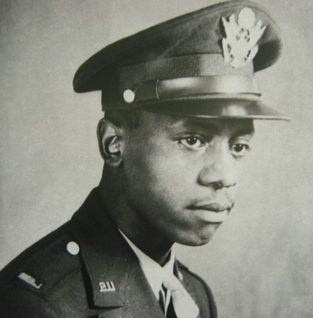
Alfonza W. Davis was the first African-American aviator from North Omaha, Nebraska, to be awarded his "wings." He was a member of the Tuskegee Airmen, a recipient of the Purple Heart, Distinguished Flying Cross and the Distinguished Unit Citation. Davis was assumed to be dead after going missing on or about 29 October 1944, over the Adriatic Sea.

Dr. Henry A. Wise Jr. M.D. was an American physician and World War II Tuskegee Airman fighter pilot with the 99th Pursuit Squadron, 332nd Division. he was shot down over Romania and was a prisoner of war. After the was he became the medical director at Bowie State University.

Lee Andrew Archer, Jr. was an African-American fighter pilot in the 332nd Fighter Group, commonly known as the Tuskegee Airmen, during World War II. He was one of the first African-American military aviators in the United States Army Air Corps, the United States Army Air Forces and later the United States Air Force, eventually earning the rank of lieutenant colonel.

First Lieutenant Robert L. Martin was a Tuskegee Airman active during World War II. His aircraft was shot down after a raid on an airfield in Yugoslavia. He was a recipient of the Distinguished Flying Cross.

2nd Lt. Alfred M. Gorham (1920-2009) was a Tuskegee Airman from Waukesha, Wisconsin. He was the only Tuskegee Airman from Wisconsin, and he was a prisoner of war after his plane went down over Munich, Germany in World War II.
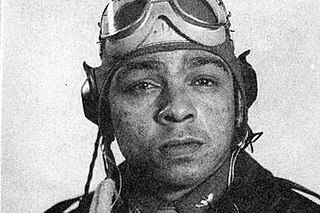
2nd Lieutenant Walter P. Manning was a member of the famed group of World War II-era African-Americans known as the Tuskegee Airmen. He flew 50 missions, and was awarded the Air Medal for heroism six times. After being shot down in 1945, he was captured in Austria and subsequently lynched by a mob. He was posthumously awarded the Congressional Gold Medal in 2007. Manning is the only known black man to have been lynched in Austria during World War II.

Flight Officer William Armstrong was a member of the famed group of World War II-era African-Americans known as the Tuskegee Airmen. His plane was shot down on Easter Sunday in 1945 over Austria. In 2018 he was inducted into the Rhode Island Aviation Hall of Fame.
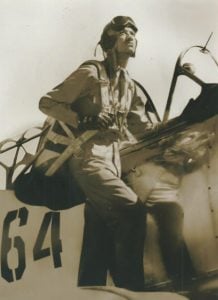
John "Ellis" Edwards was an American aviator who served with the Tuskegee Airmen during World War II. He served in the 332nd Fighter Group and earned the Distinguished Flying Cross award. He also served as a pilot in the Korean War.
Edward Lucien Toppins was a U.S. Army Air Force officer, commanding officer of the 602nd Air Engineering Squadron, and a celebrated African-American World War II fighter pilot within the 332nd Fighter Group's 99th Fighter Squadron, best known as the Tuskegee Airmen, "Red Tails," or “Schwartze Vogelmenschen” among enemy German pilots. He was one of 1,007 documented Tuskegee Airmen Pilots.
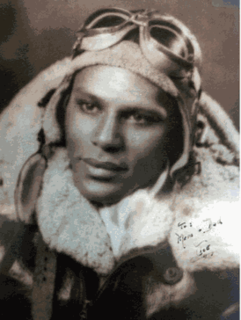
George Jewell Iles was a U.S. Army Air Force officer, former World War II Prisoner of War in Nazi Germany, and combat fighter pilot with the 332nd Fighter Group's 99th Fighter Squadron, best known as the all-African American Tuskegee Airmen.
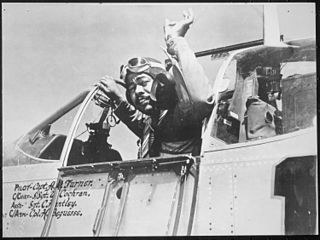
Andrew D. "Jugs" Turner was an officer in the U.S. Army Air Forces (USAAF) and a fighter pilot and commanding officer of the all-African American 332nd Fighter Group's 100th Fighter Squadron, best known as the all-African American Tuskegee Airmen, "Red Tails," or among enemy German pilots, “Schwartze Vogelmenschen”.

Herbert Vanallen Clark was a U.S. Army Air Force/U.S. Air Force officer, and combat fighter pilot with the all-African American 332nd Fighter Group, best known as the Tuskegee Airmen. He completed two tours of duty, completing ten missions on his second tour. In 1944, Clark's aircraft was shot down over Italy, and was reported as missing in action. He was picked up by the Italian resistance, evading enemies for eight months before rejoining his unit. He retired with a rank of major.

George Levi Knox II was a U.S. Army Air Force/U.S. Air Force officer, combat fighter pilot and Adjutant with the all-African American 332nd Fighter Group's 100th Fighter Squadron, best known as the Tuskegee Airmen. One of the 1,007 documented Tuskegee Airmen Pilots, he was a member of the Tuskegee Airmen's third-ever aviation cadet class, and one of the first twelve African Americans to become combat fighter pilots. He was the second Indiana native to graduate from the Tuskegee Advanced Flying School (TAFS).
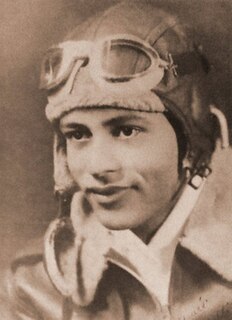
Walter Irving “Ghost” Lawson was an U.S. Army Air Force/U.S. Air Force officer and combat fighter pilot with the 332nd Fighter Group's 99th Pursuit Squadron, best known as the Tuskegee Airmen or "Red Tails". He was one of 1,007 documented Tuskegee Airmen Pilots.

Price D. Rice was a U.S. Army Air Corps/U.S. Air Force officer and combat fighter pilot of the 332nd Fighter Group's 99th Fighter Squadron, best known as the Tuskegee Airmen. He was one of 1,007 documented Tuskegee Airmen Pilots.
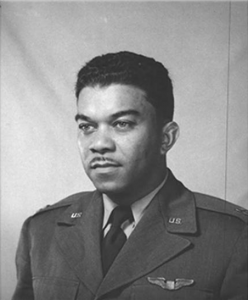
Walter Lee McCreary was an U.S. Army Air Forces/U.S. Air Force officer, former prisoner of war (POW), and one of the original combat fighter pilot with the 332nd Fighter Group's 100th Fighter Squadron, best known as the Tuskegee Airmen. He was one of the first hundred African American fighter pilots in history, as well as one of 1,007 documented Tuskegee Airmen Pilots.
Luke Joseph Weathers, Jr., was a U.S. Army Air Force officer, historic African American air traffic controller and prolific World War II combat fighter pilot with the prodigious 332nd Fighter Group's 302nd Fighter Squadron, best known as the Tuskegee Airmen, "Red Tails," or "Schwartze Vogelmenschen" among enemy German pilots. Weathers earned a Distinguished Flying Cross for defending and escorting a damaged U.S. Army Air Corps B-24 Liberator bomber against eight Messerschmitt 109s on November 16, 1944, shooting down two Me-109s.

William Hugo “Bill” Holloman III was a U.S. Army Air Force officer, combat fighter pilot, and high-profile member of the prodigious 332nd Fighter Group's 99th Fighter Squadron, best known as the Tuskegee Airmen, "Red Tails," or “Schwartze Vogelmenschen” among enemy German pilots.



















